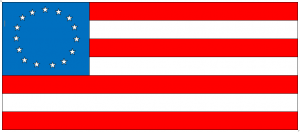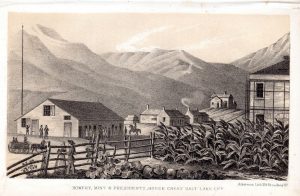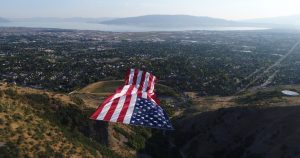Big Flags A Utah Tradition
Even before they arrived in the Valley of the Great Salt Lake, Utah’s pioneers had expressed a strong preference for big flags. During a meeting of pioneer leaders held at Winter Quarters in Nebraska, Brigham Young voiced his thoughts that a flag of 8’ by 16’ flown on a mountain would be too small to be seen a mile away. He suggested, “I think 90 by 30 better.” The council then sent Jedediah M. Grant to the East Coast sea ports to buy fabric for flags.
Over the next decades, these settlers created many big flags—and they regularly named each one “the Mammoth Flag.” A few of these Mammoth Flags, made during the first seven years of settlement, illustrate the story of Utah’s settlers and their big flags.
When Jedediah M. Grant arrived in the valley in October of 1847, he apparently brought fabric with him and a Stars and Stripes flag was made, which displayed a circle of fifteen stars in its blue union. We don’t know its size, but it was big enough to be flown on a flagpole at Salt Lake’s Old Fort.
1848 was only one year from their arrival in the Great Basin, and the pioneers kept busy bringing wagon trains west and establishing communities to receive them. By 1849, however, it was time to celebrate, and what better communicates a celebration than flying flags. During early July, the women gathered at Old Fort to “sew on the flag” which measured some sixty-five feet in length. It differed from usual Stars and Stripes in that its stripes were blue and white and it is uncertain how many stripes made up the flag’s field. Raised on a Liberty Pole at “7 ½ o’clock” was saluted by six guns and the ringing of the Nauvoo Bell.
In 1850 a 49er headed for the gold fields wrote describing the celebration with its new Mammoth Flag.
There was a tall liberty pole, from which wave the flag of Deseret. The flag was thirty
feet wide, and eighty feet long. A gale arose, the staff broke, and down came the flag,
trailing in the dust.
For July 4th of 1851 the Journal History, a written record of daily events kept by these pioneers, included the following description of a Mammoth Flag:
On the lofty summit of the pole floated in proud triumph the stripes and stars of a new
flag made for the occasion its length was forty five feet by fourteen and a half feet in
breadth, with the American Eagle stretching its wings on an area of ten feet square
within its beak the folding drapery with the inscription, “e pluribus unum,” under and
above its left wing was the Utah Arms the Beehive and the Rising Star; und the right
wing a hundred and twenty pounder discharging its contents.
The Journal History for July Fourth of 1854 recorded the following description of the celebration:
Quarter to 9.—The starting of the Escort being summoned by the firing of cannon,
it proceeded to the Governor’s residence, where, after the accustomed salutation, his Excellency, together with his Suite, were received under the flag of the Committee of Arrangements.
Upon leaving with his Excellency, the United States Mammoth Flag was unfurled
to the breeze . . .
It was not until 1896 that the concept of a Mammoth Flag found it largest interpretation. When planning the celebration of Statehood for Utah, two committee members struck on the idea that only a record setting Mammoth Flag would mirror the excitement of the occasion. Purchasing a sufficient amount of bunting fabric—costing $250—eight volunteer seamstresses sewed a forty-five star flag together measuring 74’ by 132’ to claim the title of the largest flag in the world. I would hold that record until 1923, when a larger flag was made in Detroit.
Too large for any available flagpole, it was suspended to cover the ceiling of the Salt Lake Tabernacle where the inaugural ceremonies took place. In following years during July, the truly Mammoth Flag found display covering the south wall of the Salt Lake Temple, where it stretched from towers on the East to those on the West. This flag was so large it tore apart under its own weight and was destroyed in about 1907.
Today the tradition continues with many flags measuring 30’ by 60’ or larger fly throughout the Salt Lake Valley. Many are made locally, and larger flags, along with flags that cover the playing fields in football stadiums measuring 150’ by 300’.
A current example needs to be recognized. Echoing Brigham Young’s thought that big mountains warrant big flags, Kyle Fox headed a group in Pleasant Grove Utah to produce a huge United States flag worthy of display in Grove Creek Canyon located east of his home. The span between canyon wall of over 1,100 feet called for a mammoth flag. Measuring 78 feet at the hoist and 150 long to the fly end, the flag is the largest free-flying United States flag in existence. Where was the flag—nicknamed “Big Betsy”—made. In Utah, of course, at Colonial Flag Company’s headquarters in Sandy.
At over a quarter of an acre, this gigantic flag surpasses the size of the George Washington Bridge Flag that measures 60 feet by 90 feet, which has been regularly touted as the largest free-flying U.S. flag. The flag made for Grove Canyon is also larger than Utah’s Mammoth Statehood flag of 1896 which measured 74 feet by 132 feet and could only be hung on the side of a building. However, the biggest factor Follow the Flag’s gigantic Stars and Stripes is the big impact it has had on those who have seen it displayed.
Utah is known for large mountains of the Uintah and Wasatch Ranges, and they provide amazing backdrops for Utah’s tradition of Mammoth Flags.
Big Flags? Brigham Young would be pleased.




